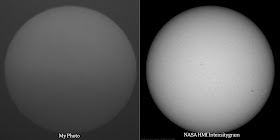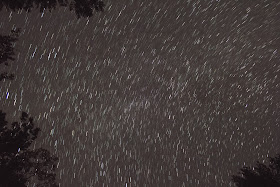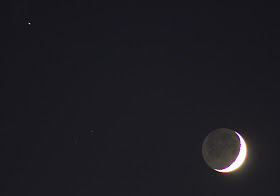 |
| Single frame with Canon T5i, f/5.6, 1 sec, ISO 800, 300mm |
My learn-by-doing astronomy and astrophotography blog and observing journal
▼
Saturday, September 27, 2014
What's That Star Next to the Moon? September 27, 2014
What is that bright star next to the moon? Well tonight it's not a star, it's the planet Saturn. At magnitude 1.3, it's about as bright as Deneb (α Cyg) or Regulus (α Cyg), and clearly stands out less than 3° from the crescent Moon.
Friday, September 26, 2014
Crescent Moonset Over Pyramid, September 26, 2014
Ok, I didn't expect to fool anyone - this isn't a pyramid in Egypt, it's my neighbor's roof - but if you tilt the photo sideways and crop it just right it could pass as a pyramid, right?
This is an uncropped photo showing the moon setting in the "sweet spot" between the roofline in my development. I actually really like this photo!! You can even see the top of the silo across the street. I love that you can just barely see this bizarre object among the rooftops, it makes me feel less boxed in by houses knowing that I can see something on the "outside."
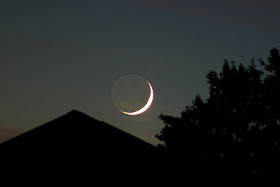 |
| Single frame with Canon T5i auto enhanced in iPhoto, ISO 200, 300mm, f/5.6, 1 sec |
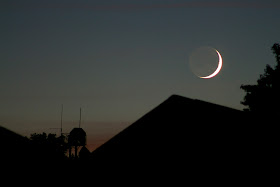 |
| Single frame with Canon T5i auto enhanced in iPhoto, ISO 200, 300mm, f/5.6, 1 sec |
This is an uncropped photo showing the moon setting in the "sweet spot" between the roofline in my development. I actually really like this photo!! You can even see the top of the silo across the street. I love that you can just barely see this bizarre object among the rooftops, it makes me feel less boxed in by houses knowing that I can see something on the "outside."
 |
| Single frame with Canon T5i, ISO 200, 300mm, f/5.6, 1 sec |
I moved the tripod back and forth until I got the shot lined up just right showing the crescent moon cradled by the roof and tree.
Monday, September 22, 2014
3% Crescent Moon with Earthshine, September 22, 2014
Chris called me on his way to work this morning and told me I better get dressed and come outside to see the slim crescent moon rising over the neighborhood with beautiful earthshine lighting up the darker side.
Moon stacking is back! Courtesy of Lightroom 5 which lets me export TIFs in the right format. I never figured it out in iPhoto after messing with it. My Canon T5i doesn't work with Adobe Camera Raw for some reason so my whole workflow got messed up. But it looks like my Lightroom workflow is working and doesn't take as much time as I thought.
I think this earthshine beats out my first earthshine photo, but it's not as good as the earthshine stack I did in March 2013 with a darker sky in the background.
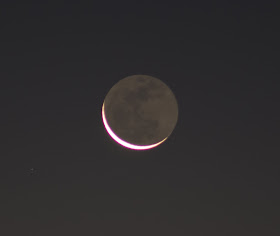 |
| Stack of 15 frames in Registax, taken with Canon T5i |
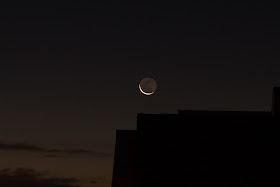 |
| Single frame with Canon T5i, f/7.1, 1.6 sec, ISO 800, 160mm |
 |
| Single frame with Canon T5i, fluorescent WB, f/5.6, 1.3 sec, ISO 800, 75mm, cropped |
Jupiter and the Two Dogs, Canis Major and Minor
I was outside before sunrise and saw Jupiter and the crescent moon forming an arc in the sky with the bright stars in Canis Major and Canis Minor. Jupiter and two dogs, it was a rather symmetrical arrangement. It was in the approximate location of a huge rainbow I saw earlier this summer.
 |
| Early morning September 20, 2014 |
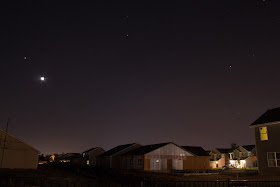 |
| Single frame with Canon T5i, fluorescent WB, f/7.1, 15 sec, ISO 800, 18mm |
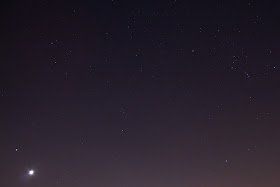 |
| Jupiter, Moon, and preview of the winter sky just before sunrise. Single frame with Canon T5i, fluorescent WB, f/5.6, 13 sec, ISO 800, 18mm |
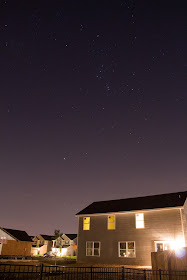 |
| Orion over my neighbor's house, Single frame with Canon T5i, fluorescent WB, f/5.6, 13 sec, ISO 800, 18mm |
 |
| Another winter sky preview - I'm excited for this awesome patch of sky to be over my backyard all winter! |
Wednesday, September 17, 2014
Eerie Yellow Ball Appears During Foggy Sunrise
What could this strange object be!? Oh, right, it's the sun. It looks very strange and eerie, similar to a foggy sunrise I saw last year. This time, I grabbed by DSLR to get a close up using the dense fog as a natural solar filter. In hindsight this was very risky and could have led to permanent damage to my eye or camera or both, but I took a chance and the dense fog held together keeping the sun rather dim.
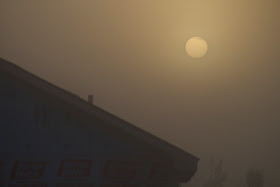 |
| Single frame with T5i, ISO 200, 200mm, f/5, 1/1000 sec |
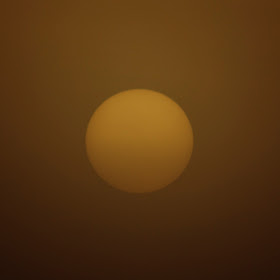 |
| I messed with this one a bunch in iPhoto so I won't give the acquisition details |
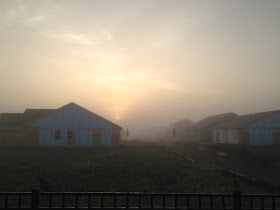 |
| Single frame, iPhone photo |
 |
| Eerie pale yellow ball, single frame with T5i at ISO 200, 300mm, f/5.6, 1/800 sec |
Tuesday, September 16, 2014
Bradford Woods Views of the Milky Way with Canon T5i
This weekend I was co-hosting a Peer Educator retreat for our health and wellness peer educators at Bradford Woods in Martinsville, IN. Bradford Woods is close to the Link Observatory, and I knew it would have better skies than my house in Noblesville, so I brought my camera along.
We had a campfire at night and I could see through the trees that the stars were crystal clear and that it was going to be a great night for stargazing.
When I put the fire out and stepped out into a clearing, I could immediately see the faint veil of the Milky Way. You know it's a great sky when you don't even recognize constellations because there are too many stars!
The clearing I was standing in was amazing, it blocked out all of the parking lot lights, and all of the lights from the cabins in the park were blocked by the tall trees. One drawback to the trees, however, is that I had no view of the horizon - and missed out on the brightest areas of the Milky Way. The region within the Summer Triangle is nice, and recognizable, but not the brightest bit by far.
Facing the other direction, and at ISO 3200, I didn't get much nebulosity in the Milky Way, but I did catch our neighbor galaxy Andromeda - which at 18mm looks like a large blurry star.
We had a campfire at night and I could see through the trees that the stars were crystal clear and that it was going to be a great night for stargazing.
When I put the fire out and stepped out into a clearing, I could immediately see the faint veil of the Milky Way. You know it's a great sky when you don't even recognize constellations because there are too many stars!
 |
| Canon T5i on fixed tripod, stack of 29 light frames at ISO 6400, f/4.5, 18mm, 10 sec Total exposure time 4 min 8 sec |
 |
| Same image as above with the Summer Triangle and Cygnus |
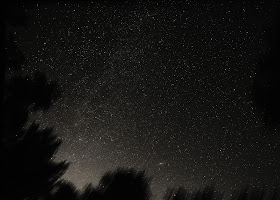 |
| Canon T5i on fixed tripod, stack of 95 light frames at ISO 3200, f/4.5, 18mm, 10 sec Total exposure time 14 min 41 sec |
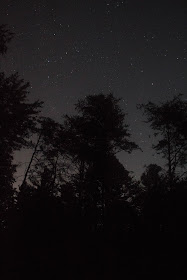 |
| Cassiopeia and Andromeda rising over the treetops Canon T5i on fixed tripod, single frame ISO 3200, 18mm, f/4.5, 10 sec |
I'll end by saying it's a good sign when the trees in the foreground are actually black at night. I'm so used to seeing houses and orange trees in the neighborhood. Even at ISO 3200, these trees make true silhouettes against the night sky. Very cool!
Wednesday, September 10, 2014
Supermoon September 8, 2014
I was driving home from Kroger and saw the most amazing moonrise over the pond in our development. Chris was nice enough to put away the groceries by himself so I could run outside and snap some supermoon photos.
It's the last supermoon of 2014. Okay, I know supermoons aren't all that super, but it's still fun to see a nice full moon on a clear night.
It's the last supermoon of 2014. Okay, I know supermoons aren't all that super, but it's still fun to see a nice full moon on a clear night.
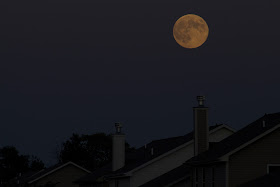 |
| Canon T5i single frame, f/9, 1/125 sec, ISO 100, 300mm |
 |
| Canon T5i single frame, f/9, 1/30 sec, ISO 100, 300mm |
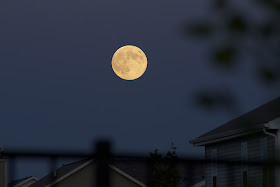 |
| Canon T5i single frame, f/9, 1/30 sec, ISO 100, 300mm |
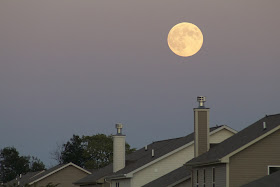 |
| Canon T5i single frame, f/7.1, 1/400 sec, ISO 1600, 300mm |
Sunday, September 7, 2014
Lagoon Nebula and Trifid Nebula with Canon T5i on Orion Motorized EQ-1
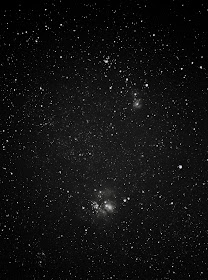 |
| Canon T5i on Orion EQ-1M, 240 subs, 46 darks, 81 bias, ISO 800, 6 sec, f/5.6, 300mm |
This stack is a total exposure time of about 24 minutes, which is by far the longest net light exposure I've ever done. You can clearly see the nebulosity in both nebulae. I also spent about 2 hours processing this image, and learned a new and better way to stretch curves in Photoshop rather than in Deep Sky Stacker. DSS is nice to get a rough approximation, but curves in Photoshop come out a lot smoother.
I also used my subtract Gaussian Blur technique for light pollution to remove the hot spot gradient in the middle of the image. It was a quick fix, but it did the job. I tried using a star mask without success, I guess I just don't understand how that works just yet - but the subtracted blur layer does a nice job removing gradient fuzz.
 |
| Canon T5i on Orion EQ-1M |
I could get 6 sec exposures without star trails, which is shorter than I got the other night on Andromeda, because the stars closer to the celestial equator appear to be moving faster than stars closer to the celestial pole.
Friday, September 5, 2014
Moon and Balloon in the Afternoon
I live next to a grass runway airfield, so we see prop planes and hot air balloons all the time. I was watering my bushes when I saw this balloon getting closer to the moon so I ran inside to get my camera. I was really hoping to see the balloon occult the moon, but this close approach was still photo worthy.
With the number of historic planes and other small aircraft in the area, I'm really hoping for a photo of a balloon or a plane in front of the moon. Here's hoping!
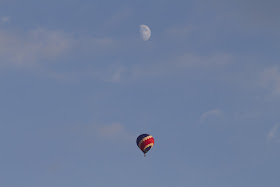 |
| Canon T5i handheld, ISO 100, 140mm, f/6.3, 1/250 sec |
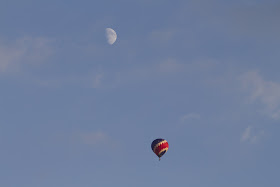 |
| Canon T5i handheld, ISO 100, 140mm, f/6.3, 1/250 sec |
 |
| Canon T5i handheld, ISO 250, 300mm, f/7.1, 1/500 sec |
With the number of historic planes and other small aircraft in the area, I'm really hoping for a photo of a balloon or a plane in front of the moon. Here's hoping!
Monday, September 1, 2014
Kicking Off Andromeda Season with First Successful Motorized EQ-1 Run
I haven't done a good Andromeda attempt since 'Andromeda Season' kicked off last year in September. At that point, I made incremental baby steps to finally visualize some dark dust trails in the spiral arms of our galactic neighbor. Last year I was reaching the upper limit of what I could do with a fixed tripod - which limits me to 1.3 sec exposures at 300mm.
I got the Orion EQ-1 mount last Christmas, but I didn't really get to USE it, I did try setting it up once on my balcony but I was nervous about dropping screws through the floorboards.
I was trying to figure out how to slew the camera to the right position in the sky without unhooking and re-attaching the motor. It is delicate and uses a tiny hex screw to attach to the gear wormscrew attachment thinggy. Was I seriously expected to slew to the right spot, and then unhook the manual knob and replace it with the motor out in the field??
I avoided using it until I had my own place to really sit down and figure it out. While I was setting up last night, I noticed the thumb screws on the mount - and I tried loosening them to slew without unhooking the motor. It worked! This might seem obvious, but to a self-taught amateur this was the secret that made the setup a lot more user-friendly... I'm much more likely to use the EQ-1 mount now that I know I can leave the motor attached while I slew to the approximate location.
I set up on the front walkway with a kitchen chair. I did a rough polar alignment - I still need to figure out a good way to align correctly with a camera since I don't have a finder scope (and really good alignment was never important before with just observing manually).
After aligning to Polaris, I loosened the thumbscrews and slewed toward Andromeda. I found it easy enough because I've been observing it for a couple years now. I did a test shot of 15 seconds at ISO 1600 and found that not only was I getting some small trails but the light pollution was washing out the photo. I pulled back to 13 seconds and the trails were insignificant. This is a pretty crappy polar alignment but WAY more light gathering potential compared to 1.3 second frames!
I took a quick stack and then noticed clouds getting in the way. I waited a little bit and then played with ISO 800 for 13 sec to see what that would look like. I took some dark and bias frames and stacked in Deep Sky Stacker this morning.
I got the Orion EQ-1 mount last Christmas, but I didn't really get to USE it, I did try setting it up once on my balcony but I was nervous about dropping screws through the floorboards.
I was trying to figure out how to slew the camera to the right position in the sky without unhooking and re-attaching the motor. It is delicate and uses a tiny hex screw to attach to the gear wormscrew attachment thinggy. Was I seriously expected to slew to the right spot, and then unhook the manual knob and replace it with the motor out in the field??
I avoided using it until I had my own place to really sit down and figure it out. While I was setting up last night, I noticed the thumb screws on the mount - and I tried loosening them to slew without unhooking the motor. It worked! This might seem obvious, but to a self-taught amateur this was the secret that made the setup a lot more user-friendly... I'm much more likely to use the EQ-1 mount now that I know I can leave the motor attached while I slew to the approximate location.
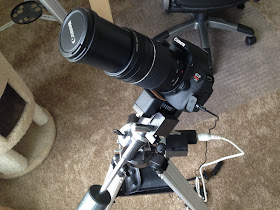 |
| Canon T5i on Orion 9011 EQ-1 Equatorial Telescope Mount |
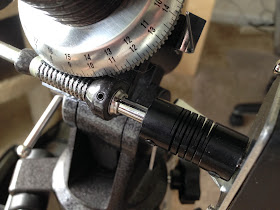 |
| Orion 7826 EQ-1M Electronic Telescope Drive attached to the wormscrew |
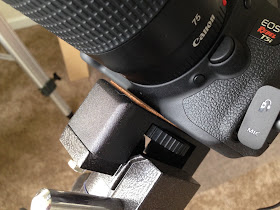 |
| Camera attaches with the Orion 10103 1/4-Inch-20 Adapter for EQ1 Telescope Mount |
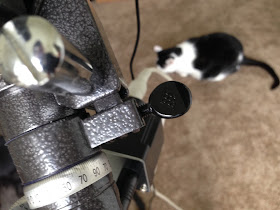 |
| Thumbscrew that loosens the ascension axis |
 |
| EQ-1 motor driving the declination axis |
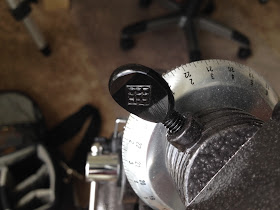 |
| Thumb screw that loosens the declination axis so you don't have to unhook the motor |
After aligning to Polaris, I loosened the thumbscrews and slewed toward Andromeda. I found it easy enough because I've been observing it for a couple years now. I did a test shot of 15 seconds at ISO 1600 and found that not only was I getting some small trails but the light pollution was washing out the photo. I pulled back to 13 seconds and the trails were insignificant. This is a pretty crappy polar alignment but WAY more light gathering potential compared to 1.3 second frames!
I took a quick stack and then noticed clouds getting in the way. I waited a little bit and then played with ISO 800 for 13 sec to see what that would look like. I took some dark and bias frames and stacked in Deep Sky Stacker this morning.
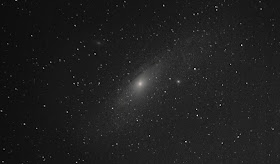 |
| Canon T5i on EQ-1 mount, 9 subs at ISO 1600, 14 subs at ISO 800, all 13 sec, f/5.6, 300mm, 21 dark frames, 21 bias frames |
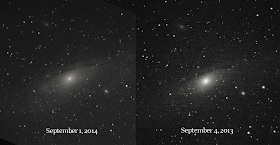 |
| Incremental improvement in the past year, particularly the longer exposure time reduces the grain... e.g. more 'real photo' and less computer manipulation of noise to extract the signal |
